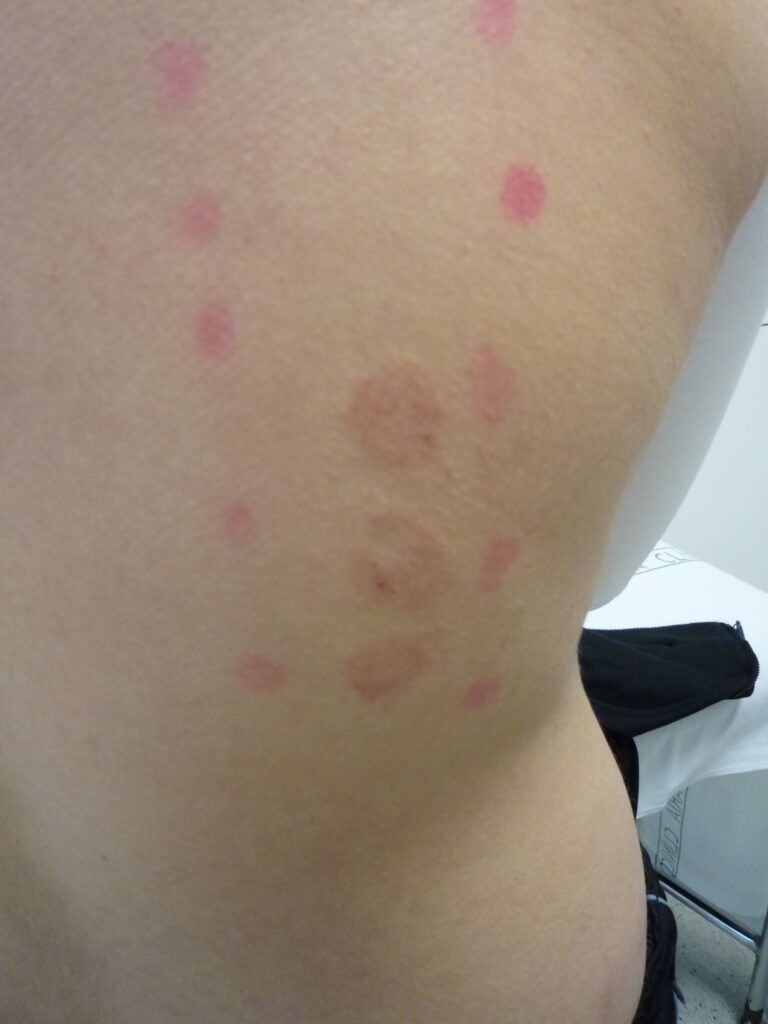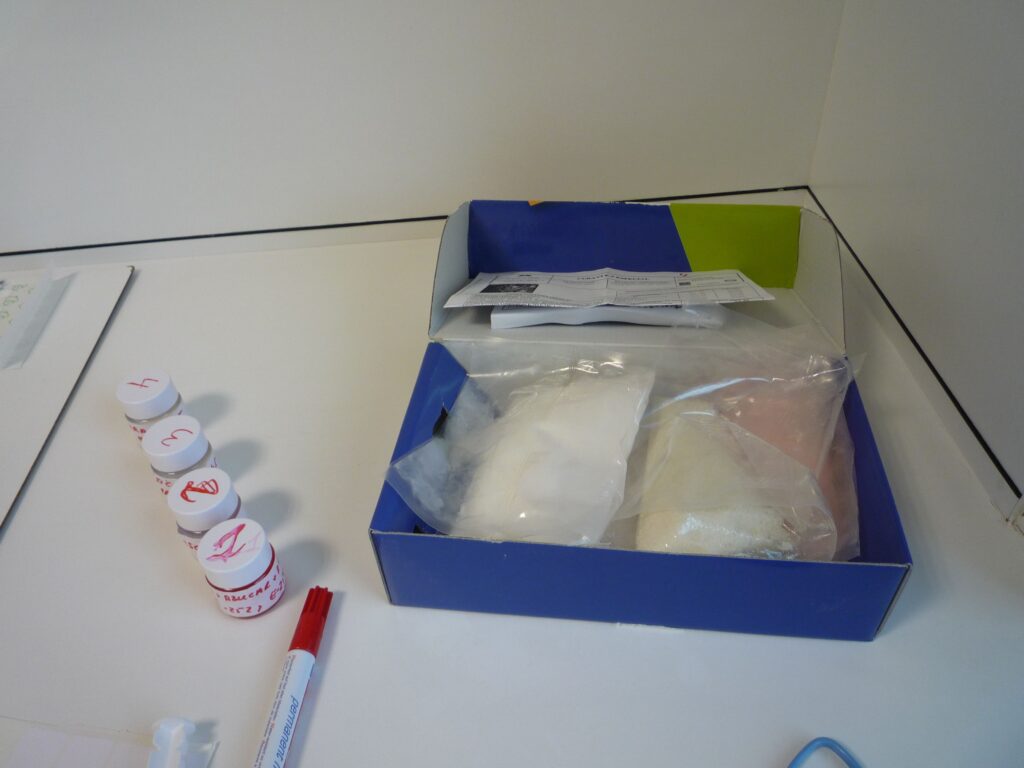Gina Grimalt1, Enrico Valerio2, Mario Cutrone3, Ramon Grimalt1*
1Facultat de Medicina i Ciències de la Salut. UIC-Barcelona, Universitat Internacional de Catalunya, Sant Cugat del Vallès, Barcelona, Spain
2Unità Operativa di Pediatria, Ospedale dell’Angelo, Venice, Italy
3Neonatal Intensive Care Unit, Department of Woman and Child Health, University of Padova, Italy
*Corresponding Author: Ramon Grimalt, Facultat de Medicina i Ciències de la Salut. UIC-Barcelona, Universitat Internacional de Catalunya, Sant Cugat del Vallès, Barcelona, Spain; Email: [email protected]
Published Date: 23-01-2021
Copyright© 2021 by Grimalt G, et al. All rights reserved. This is an open access article distributed under the terms of the Creative Commons Attribution License, which permits unrestricted use, distribution, and reproduction in any medium, provided the original author and source are credited.
Abstract
A 42-year-old man working as a specialized deboning butcher (deshuesador) in a “Jamon Serrano” factory in Spain presented with a professional hand contact dermatitis.
We patch tested the patient with the rope that is used to hang the pig leg, with the grease covering the skin of the pork leg, with the grease covering the rope and with the grease in close contact to the ham itself.
Patch test showed positive results at day 2 and 4 to the external grease and negative results to the rest.
We path test 10 volunteers to exclude irritant contact dermatitis. One patient showed positive result to the grease, rope and grease covering the rope, rest of volunteers showed negative results. We patch tested the products used to cure the ham: rosed jam, marine salt H3, nitrificant 45 and curavi E-5 with negative results.
We studied preservatives present on the different types of curing salt: E-310, E-250, E-331 and E-252. Accordingly, we also tested: sodium ascorbate 1% and 5%, sodium nitrite 10% trisodium citrate 10% and potassium nitrate at 10%, with negative results. The case was finally considered to be an irritant contact dermatitis from “serrano ham”.
Keywords
Contact Dermatitis; Food Industry; Preservatives; Salt; Pig Leg; Cured Ham; Grease; Cured Ham; Jamon Serrano
Abbreviations
NaCl: Sodium chloride
Salt h3: A type of salt used for the process of making ham
Nitrificant campa 45: A special type of salt
Curaví e-5 special: A third type of salt used in the process
E-252: Preservative 252
E-250: Preservative
E-310: Antioidant 310
E-331: Antioxidant 331
Introduction
Ham industry is economically relevant in some areas of Spain. Many pork farms cover the surface of the western part of the plateau “la meseta”. Ham can be bought directly as a unique piece and is a common Christmas present. Nevertheless in most occasions ham is sold as separate pieces or already cut and sliced.
As the pig leg has the bones inside someone has to cut the meet out of the bone (deshuesador) in order to put the pieces of cured meet into the cutting slicing machine.
Most pig legs are covered by salt as part of the process of curing them. As we find out preparing this manuscript, all manufactures have to follow Spanish sanitary rules and all ham factories use the same type of products and preservatives on the process of curing the jamon. These substances include four types of salt namely rosed jam, wet marine salt h3, nitrificant campa 45 and curaví e-5 special. These 4 types of products used to cure ham are mainly different types of salts, NaCl. The preservatives present in these products are E-252 and E-250 and the antioxidants E-310 and E-331.
Clinical Case
A 42-year-old healthy man, without any past history of known allergy was referred to our department with the suspicion of professional hand dermatitis.
He worked in the industry of the “serrano ham” working as specialized butcher on the deboning of the leg pork.
He referred typical clinical manifestations of professional hand dermatitis with improvement on vacation and during weekends.
The present dermatitis affected the dorsal aspect of both hands with dry and eczematous aspects (Fig. 1).
Figure 1: Dorsal hand contact dermatitis on a specialized deboning butcher (deshuesador) in a “Jamon Serrano” factory.
Methods
The patch tests were administered with Curatest™ patch-test chambers (Lohmann-Rauscher International GMBH and Co.KG, Germany), applied on the back with Micropore™ (3M Health Care, Borken, Germany). The patch test readings were performed according to the international guidelines by the International Contact Dermatitis Research Group after 2 and 4 days.
Standard series from chemoteqnique were carried out, as well as 4 additional patches including: a patch test with the external grease covering the ham, a small piece of grease covering the internal part of the ham, the grease covering the rope and the rope used to hang the ham (Fig. 2).

Figure 2: The different types of grease the patient brought.
Standard test series
Positivity at 48 and 96 hours to: nickel sulphate (++).
Own products
Positivity at 48 and 96 hours to: external grease (+++).
The positive result to nickel sulphate is past relevant or unknown, as the patient is not using any jewellery.
The positivity to the external grease is clearly related to the clinical suspicion.
Controls
Ten patients attending our clinic to be path tested were included as controls.
Only one out of the ten controls showed a moderate (+) reaction to the external grease, grease covering the rope and internal grease (Fig. 3). The rest of controls and patch tested material (rope) showed negative results.
We contact the factory and they send us the products they use for the process of drying and curing the ham. They include four types of salt namely rosed jam, wet marine salt h3, nitrificant campa 45 and curaví e-5 special (Fig. 4). The preservatives present in these products are E-252 and E-250 and the antioxidants E-310 and E-331.
We patch tested again the patient with the 4 products diluted in water in 3 different concentrations (Fig. 4).
The results were positive at all concentration for product 1 and negative for product 2, 3 and 4.
We asked a specialized pharmacy to prepare solutions of the preservatives to be patch tested E-252 and E-250 and the antioxidants E-301 and E-331i present in the different salts (Fig. 5).
The patient was negative at day 2 and 4 to all 4 tested preservatives.
Controls: We patch tested 10 patients with the 3 different concentrations of the 4 substances and the 5 preservatives and antioxidants. Results at 48 and 96 hours showed no reaction.

Figure 3: Irritant response in one of the controls to the 3 different types of grease.

Figure 4: We received from factory the 4 types of salt used to cover the skin of the pork leg. We patch tested the patient and control with different dilutions of these salts.

Figure 5: The different preservatives prepared to be patch tested.
Discussion
Sometimes to differentiate allergic from irritant contact dermatitis can be rather complex [1]. Many papers deal with this matter and try to point out what is the clue [2-6]. Standards of different protocols are published every year regarding this point [7-9].
The elaboration process of the world famous “Jamon Serrano” is a complicated and in most cases a well-kept secret method.
In most cases the pork leg after being cut from the animal is usually embedded in salt for a determined amount of time and then is hanged in a “drying room”. In other styles of curing, the leg is left totally buried under salt and then hanged in the drying room. In most occasions this decision is related to climate exigencies. As long as it stays covered or buried in salt the amount of water will decrease faster and the meat will taste saltier and the leg will weigh less. The best well-kept secret of these artisanal factories is the amount of time, number of salts, drying room and climate exposure to the drying meet. There are also obviously other extremely relevant factors affecting the creation of the best “Serrano ham” namely the food used to feed pigs and the “pedigree” of the animal, but as this does not interfere our study, we shall not discuss about it.
The salt, the natural grease of the animal and the humidity create a peculiar coverage to the pork leg. Natural infections mostly fungal may develop on top of the pork skin. In order to avoid them, manufacturers have to add some preservatives before hanging the pork leg.
We have contacted with the Spanish manufacturer of the “Jamon Serrano” (Antonio Villoria S, A, Arganda del Rey, Madrid) and they stated they used the official and obliged preservatives that the Spanish sanitary ministry dictates.
The close study of these products only revealed different types of salts with some preservatives.
In our patients all patch tested material showed negative results leading us to conclude towards an irritant contact dermatitis.
There is only one paper in relation to salt and professional chronic ulcers and a second one on the role of the mites covering some of the local food [9,10].
From our point of view this is an interesting professional contact dermatitis case. Although the difficulties and duration of the study i.e., contacting the factory, elaborating different salt concentrations, convincing controls and preparing the preservatives and antioxidants to be patch tested, we could not demonstrate allergic contact dermatitis.
Conclusion
We believe that this is the first report of allergic contact dermatitis to the grease covering a “Jamon Serrano”. In the presented case we could not found the containing product of the grease that could be causative.
References
- Novak-Bilić G, Vučić M, Japundžić I, Meštrović-Štefekov J, Stanić-Duktaj S, Lugović-Mihić L. Irritant and allergic contact dermatitis-skin lesion characteristics. Acta Clinica Croatica. 2018;57(4.):713-9.
- Murphy PB, Hooten JN, Atwater AR, Gossman W. Allergic Contact Dermatitis. In StatPearls [Internet] 2019. StatPearls Publishing.
- Usatine RP, Riojas M. Diagnosis and management of contact dermatitis. Am Fam Physician. 2010;82(3):249-55.
- Litchman G, Nair PA, Atwater AR, Bhutta BS. Contact Dermatitis. In: StatPearls [Internet] 2020. Treasure Island (FL): StatPearls Publishing.
- Rodrigues DF, Goulart EM. Patch-test results in children and adolescents: systematic review of a 15-year period. An Bras Dermatol. 2016;91(1):64-72.
- Brasch J, Becker D, Aberer W, Bircher A, Kränke B, Jung K, et al. Guideline contact dermatitis: S1-Guidelines of the German Contact Allergy Group (DKG) of the German Dermatology Society (DDG), the Information Network of Dermatological Clinics (IVDK), the German Society for Allergology and Clinical Immunology (DGAKI), the Working Group for Occupational and Environmental Dermatology (ABD) of the DDG, the Medical Association of German Allergologists (AeDA), the Professional Association of German Dermatologists (BVDD) and the DDG. Allergo J Int. 2014;23(4):126-38.
- Adisesh A, Robinson E, Nicholson PJ, Sen D, Wilkinson M. Standards of care working group. UK standards of care for occupational contact dermatitis and occupational contact urticaria. Br J Dermatol. 2013;168(6):1167-75.
- Nowak D, Gomułka K, Dziemieszonek P, Panaszek B. Systemowe kontaktowe zapalenie skóry [systemic contact dermatitis]. Postepy Hig Med Dosw. 2016;70:124-34.
- Stinco G, Pillon B, Trotter D, Patrone P. Contact ulceration from the salting of ham. Contact Dermatitis. 2003;49:219-20.
- Armentia A, Fernandez A, Perez-Santos C, de la Fuente R, Sanchez P, Sanchis F, et al. Occupational allergy to mites in salty ham, chorizo and cheese. Allergol Immunopathol (Madr). 1994;22:152-4.
Article Type
Case Report
Publication History
Received Date: 14-12-2020
Accepted Date: 15-01-2021
Published Date: 23-01-202
Copyright© 2021 by Grimalt G, et al. All rights reserved. This is an open access article distributed under the terms of the Creative Commons Attribution License, which permits unrestricted use, distribution, and reproduction in any medium, provided the original author and source are credited.
Citation: Grimalt R, et al. Contact Dermatitis from Jamon Serrano. J Clin Immunol Microbiol. 2021;2(1):1-9.
Figure 1: Dorsal hand contact dermatitis on a specialized deboning butcher (deshuesador) in a “Jamon Serrano” factory.

Figure 2: The different types of grease the patient brought.

Figure 3: Irritant response in one of the controls to the 3 different types of grease.

Figure 4: We received from factory the 4 types of salt used to cover the skin of the pork leg. We patch tested the patient and control with different dilutions of these salts.

Figure 5: The different preservatives prepared to be patch tested.


